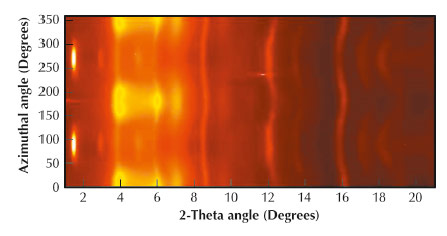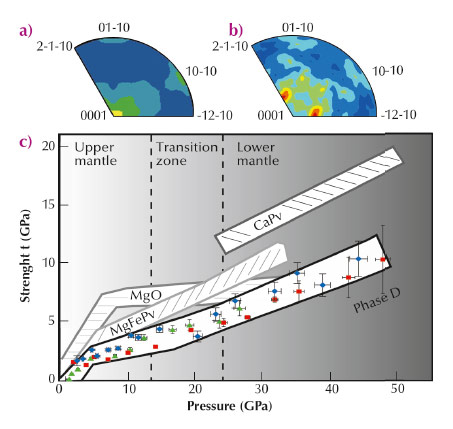- Home
- Users & Science
- Scientific Documentation
- ESRF Highlights
- ESRF Highlights 2013
- Dynamics and extreme conditions
- Prospecting for deep water with X-rays
Prospecting for deep water with X-rays
The Earth’s interior could contain more than three times the amount of water present at its surface, water that is incorporated into the structure of high pressure crystalline silicates [1]. This “water” plays a critical role in deep geological processes that shape the inner (and surface) evolution of the Earth. Indeed, minute amounts of hydrous components in silicates have major effects on mantle convection and melting, fuel plate tectonics and influence catastrophic events, such as earthquakes and volcanic eruptions.
Exchanges between the Earth’s surface and its interior recycle water over geological timescales of millions of years. Water is reintroduced into the deep Earth by hydrated oceanic tectonic plates in subduction zones. Even if much of the water is released at shallow depths (< 200 km) and returns to the surface by volcanism, a large fraction is retained in the slab and could travel beyond 400 km in depth. However, the extent of water recycling in volcanic arcs and the degree of hydration of subducted plates descending below the transition zone (TZ, > 700 km depth), remain uncertain [2].
Constraints on the deep water cycle thus rely upon the interpretation of remote geophysical observations. Seismic studies [3] show regions of negative velocity anomalies (~3%) and high shear-wave VS anisotropy (0.9 ± 0.3%) in the Tonga slab below the TZ that may be associated with the presence of hydrous phases. Phase D, (Mg,Fe,Al)Si2H2O6, is the stable water carrier in the subducted hydrated mantle (peridotite) below the TZ and a plausible candidate to explain these anomalies due to its high water content (10-18 wt% H2O) and large intrinsic anisotropy [4]. A better knowledge of the elasticity and deformation mechanism of phase D is therefore seminal for the quantitative interpretation of these seismic anomalies in terms of hydration.
We conducted experiments at beamline ID09A to determine the deformation mechanisms and lattice preferred orientations (LPO) of phase D at pressures relevant for slabs penetrating below the TZ. Powdered samples of phase D were deformed non-hydrostatically in uniaxial compression up to 48 GPa in a diamond anvil cell. X-ray diffraction patterns were collected in radial geometry to monitor the lattice strain and the development of texture in the sample under pressure (Figure 29).
 |
|
Fig. 29: Unrolled X-ray diffraction image of phase D collected at 48 GPa. Changes in the intensity with the azimuth angle and the strong modulations of the diffraction lines upon compression are indicative of strong textures and high lattice strain. |
At low strains, the layered structure of phase D displays strong 0001 texture, where the stacking fault axis (c-axis) preferentially aligns parallel to the compression axis. A subsidiary 10-10 texture develops at pressures above 19 GPa (Figure 30a). Plasticity simulations in polycrystalline aggregates using a viscoplastic self-consistent model showed that the LPO of phase D at the uppermost lower mantle (23-35 GPa, 700 – 1200 km depth) are mainly consistent with dominant easy glide on basal planes and with the harder first order pyramidal slip, respectively (Figure 30b). Furthermore, phase D displays the lowest strength among phases in hydrous peridotite in this region (Figure 30c). Phase D might thus accommodate most of the strain and might develop strong textures upon slab deformation, being a major source of shear anisotropy below the TZ.
 |
|
Fig. 30: a) Experimental and b) simulated inverse pole figures of phase D at 48 GPa showing the orientation distribution density of the compression axis within the trigonal lattice frame of Phase D crystallites in the sample. Strong 0001 texture and a subsidiary 10-10 texture are observed. c) Strength of phases coexisting in the hydrated mantle within subducting slabs at lower mantle pressures. Symbols are data for Phase D: red, Mg-bearing; blue, Fe-bearing; green, Al-Fe-bearing Phase D. [MgFePv, (Mg0.9Fe0.1)SiO3 perovskite; CaPv, CaSiO3 perovskite; MgO, periclase]. |
The effect of textured phase D on the seismic velocity structure and shear anisotropy of deformed hydrous peridotite could be modelled thanks to these results coupled with elasticity data from Brillouin scattering studies [4], allow modelling. On the basis of these calculations, our results show that 16 vol.% of phase D in subducted hydrous peridotite explains all seismic anomalies reported in the Tonga subduction below the TZ [3]. The seismic observations thus place constraints on the degree of hydration of the Tonga slab beyond the transition zone, leading to the requirement that a minimum of 1.2 wt.% H2O is retained in the slab by hydrous peridotite below 700 km depth. The implications of these results are far reaching because they provide evidence for substantial hydration of subducting plates penetrating below the TZ, in contrast with previous views [2].
Principal publication and authors
A.D. Rosa (a), C. Sanchez-Valle (a), C. Nisr (b), S.R. Evans (c), R. Debord (d) and S. Merkel (b), Earth and Planetary Science Letters 377–378, 13–22 (2013).
(a) Institute for Geochemistry and Petrology, ETH Zurich (Switzerland)
(b) Unité Matériaux et Transformations, CNRS, Université de Lille (France)
(c) ESRF
(d) Institut Lumière Matière, UMR5306 CNRS – UCBL Lyon 1, Villeurbanne (France)
References
[1] A.B. Thompson, Nature 358, 295 (1992)
[2] H.W. Green II, W.P. Chen and M.R. Brudzinski, Nature 467, 828 (2010).
[3] W.P. Chen and M.R. Brudzinski, Geophys Res Lett 30, 1682 (2003).
[4] A.D. Rosa, C. Sanchez-Valle and S. Ghosh, Geophys Res Lett 39, L06304 (2012).



